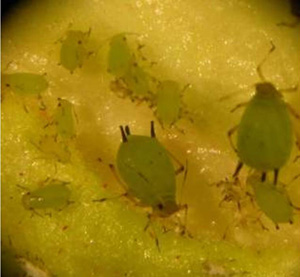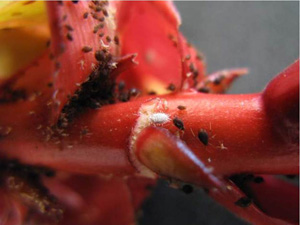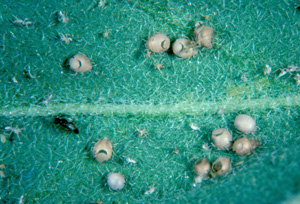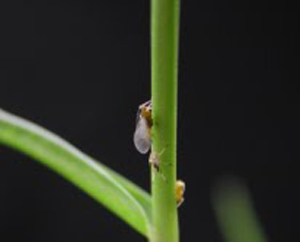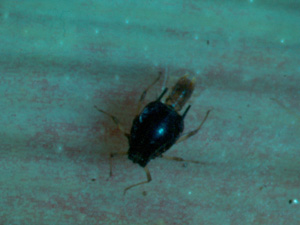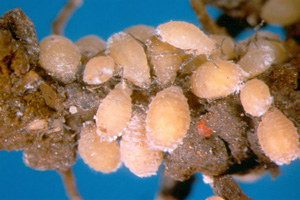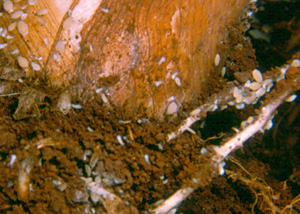Aphids
Click on images to enlarge.
Cotton aphids
Photo: Dr. Arnold H. Hara, CTAHR
Banana aphids (and single mealybug)
Photo: Dr. Arnold H. Hara, CTAHR
Mummified aphids and parasite. Do not use broad spectrum pesticides to control aphids as you will kill natural predators and make the problem worse.
Photo: Dr. Arnold H. Hara, CTAHR
Problem
Leaves on trees or garden plants are curling, distorted or stunted. There may be a black substance on some of the leaves and/or leaves may be sticky to the touch. The presence of ants may be noticed.
Description
Aphids are small, soft-bodied insects with piercing mouthparts. They may be green, yellow, brown, red or black. Aphids are pear shaped, have long legs and can be identified by the cornicle or tubelike structure which projects from the hind end of the body. They are usually wingless, but you may see adults with wings (alates) when the populations are high.
Aphid alate. The development of wings allows aphids to migrate to new hosts.
Photo: Dr. Russell Nagata, CTAHR
The presence of black sooty mold on the leaves indicates aphid, whitefly or scale infestation. Sooty mold is produced when aphids feed on leaves and excrete honeydew. Ants are also attracted by the sweet honeydew and will “farm” the aphids, moving them from leaf to leaf. Generally, small populations of aphids are not damaging to plants. Curling and distorted leaves indicate a larger infestation and aphid-transmitted viruses.
Banana aphid, live birth
Photo: Dr. Arnold H. Hara, CTAHR
Information
- Aphids: Quick Tips (UC Davis)
- Aphids (UC Davis)
- Beneficial Insects (biological aphid control with ladybugs, etc.)
Control
Avoid the use of broad spectrum pesticides as these will kill natural predators of the aphid and you will increase your problem. We recommend use of insecticidal soap spray (a commercial product or use the recipe provided below) to control the aphids, in tandem with control of the ants. The soap spray will only kill the aphids it contacts so be sure you spray under the leaves; you will also need to repeat the application once a week for several weeks until the infestation is under control. Sooty mold can be washed off the leaves with soapy water. Use mild dishwashing soap so that you do not damage the plant. You may also be able to control aphids by washing them off with water every few days. Control the ant population with a sticky barrier around the trunk of the tree, or with ant bait in your garden.
Taro root aphid
Photo: Walter T. Nagamine, HDOA
Taro root aphid
Photo: Walter T. Nagamine, HDOA
Soft Bodied Insect Spray Recipe
(controls aphids, mealybugs, whiteflies, scales, citrus black flies)
Begin by preparing a stock solution of Soap-Oil Concentrate:
- Combine 1 Tablespoon of mild dishwashing liquid (Ivory, Joy or Dr. Bronner’s, NOT ultra formulas like Dawn) with
- 1 Cup of vegetable oil (peanut, safflower, corn, soybean, sunflower oil)
How to use the Soap-Oil Concentrate:
- Shake the solution of Soap-Oil Concentrate very well before use
- Dilute with water by mixing 1-2 teaspoons of concentrate into 1 cup of tap water.
- Spray plants thoroughly in the morning or late afternoon, especially the undersides of leaves
- Spray once a week for 2 or 3 weeks to eliminate the insects.
Source: Agricultural Research Service/November 1992
Kendal Lyon, Hawaii Island Master Gardeners


